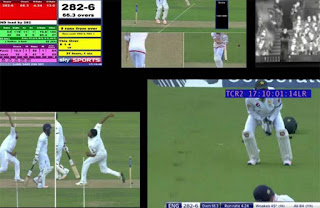new no ball tecnology
/
0 Comments
ICC to trial new no ball technology
The no ball might no
longer be in the hands of the on-field umpire
Governing
body hopes to use the third umpire to handle front foot no balls
The International
Cricket Council announced Saturday the trial of the use of technology to more
accurately detect no balls.
The trial, which will
be undertaken in England’s five-match one-day international series against
Pakistan starting next Wednesday, will see whether the third umpire will be
able to detect no balls and relay the information to the on-field umpire within
a few seconds.
The third umpire will
have access to the four side-on cameras, used for checking no balls, run outs
and stumping, along with instant slow motion replays to determine whether a
bowler has overstepped the popping crease.
Throughout the trial,
the on-field umpires will not call any front foot no balls without instruction
from the third umpire, who will relay the information to the standing officials
wearing a ‘pager’ watch.
The ‘pager’ watch will
vibrate when the third umpire has deemed a no ball has been bowled. If the
‘pager’ watch fails to work, the third umpire will advise the on-filed umpire
through the normal channels of communication.
The 'pager' watch set to be used by the on-field umpires
"This trial is
being carried out to ascertain if there is a way in which front foot no balls
can be called more accurately and consistently, while also assessing the TV
umpire’s workload and identifying the impact it will have on the flow of the
game," ICC Senior Manager – Umpires and Referees, Adrian Griffith, said.
"While we need to
find out if the technology set-up for this purpose is fit, at the same time we
feel this is the right time to conduct the trial as the TV umpires will have
more information than ever before to share with the on-field umpires, which, in
turn, will help them in correct decision-making,
"To ensure that
the match officials are thoroughly briefed and trained for this trial, the ICC
will conduct training sessions with the umpires and match referee in
Southampton on Monday and Tuesday. The results of this technology trial will be
shared with the ICC Cricket Committee, which will advise the ICC on future
action."
The third umpire's split
screens
After a series of wickets
fell on no balls during last summer, Cricket Australia used a piece of equipment on their Test tour of New
Zealand to help detect a bowler overstepping at training.
The equipment
comprises two lengths of timber that are placed either side of the pitch at the
non-striker’s end and are fitted with sensors that align to the return and popping
crease.
A beam is relayed to a
nearby remote signal box which emits a loud ‘beep’ when a bowler’s foot comes
down wholly beyond the front (popping) crease, as well as provide a reading on
how far the guilty victim overstepped.
While the equipment in
its current iteration is too large to carry as regular kit, progress is being
made to reduce the size and weight so it can be transported with the team.
As it currently
stands, the on-field umpire can ask the third umpire to check for a front foot
no ball on a wicket-taking delivery.
However, there was controversy in the series when Australia
batsman Adam Voges was given a reprieve when the on-field umpire, Richard
Illingworth, called a no ball after the batsman shouldered arms and was bowled
by Blackcaps paceman Doug Bracewell.
Replays indicated
Bracewell did in fact have some of his front foot behind the popping crease,
but because the call was made by the on-field umpire it could not be
reversed.



